When Big Rivers Started to Drain to the Arctic Basin: A View from the Kara Sea
Abstract
1. Introduction
2. Materials and Methods
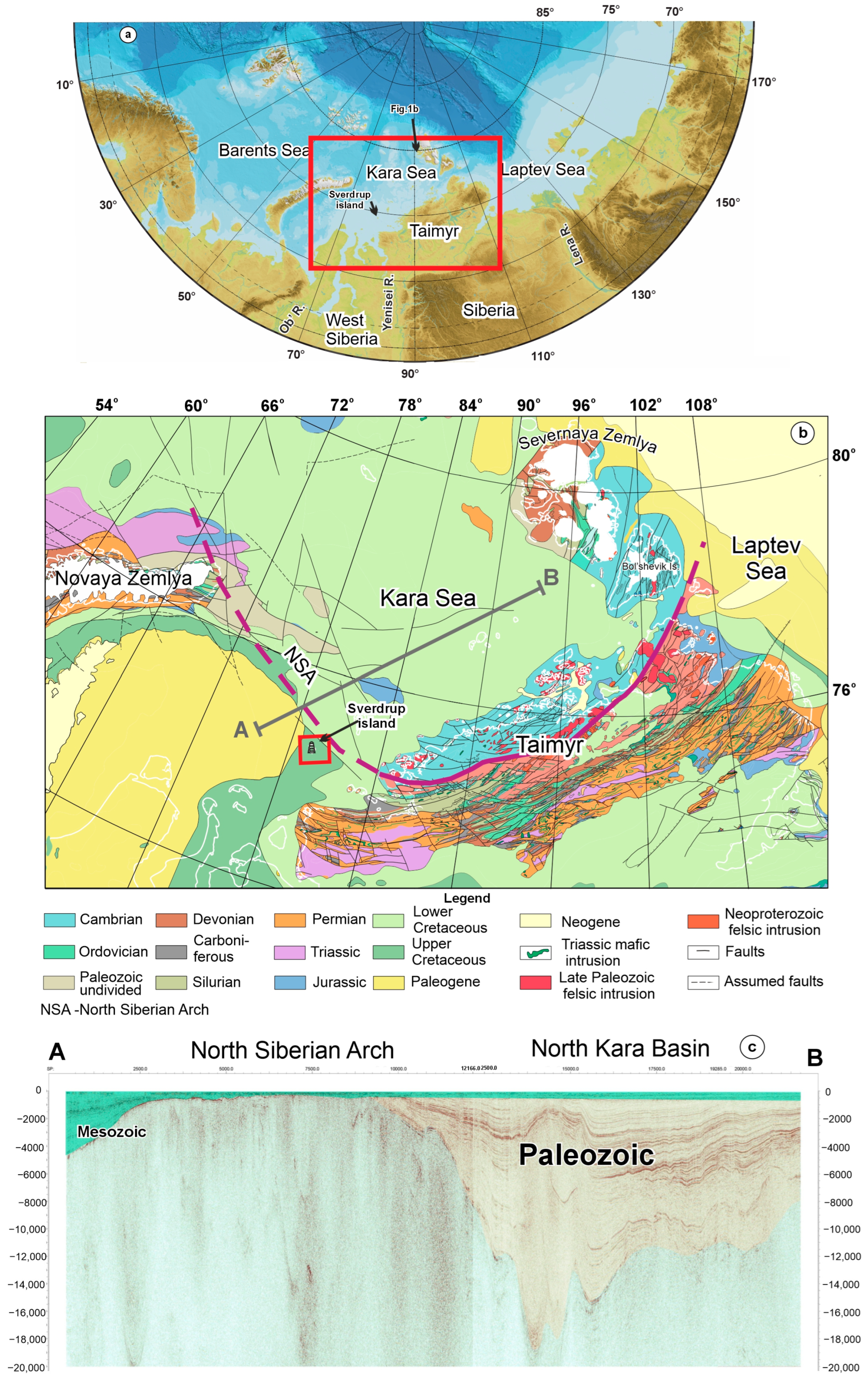
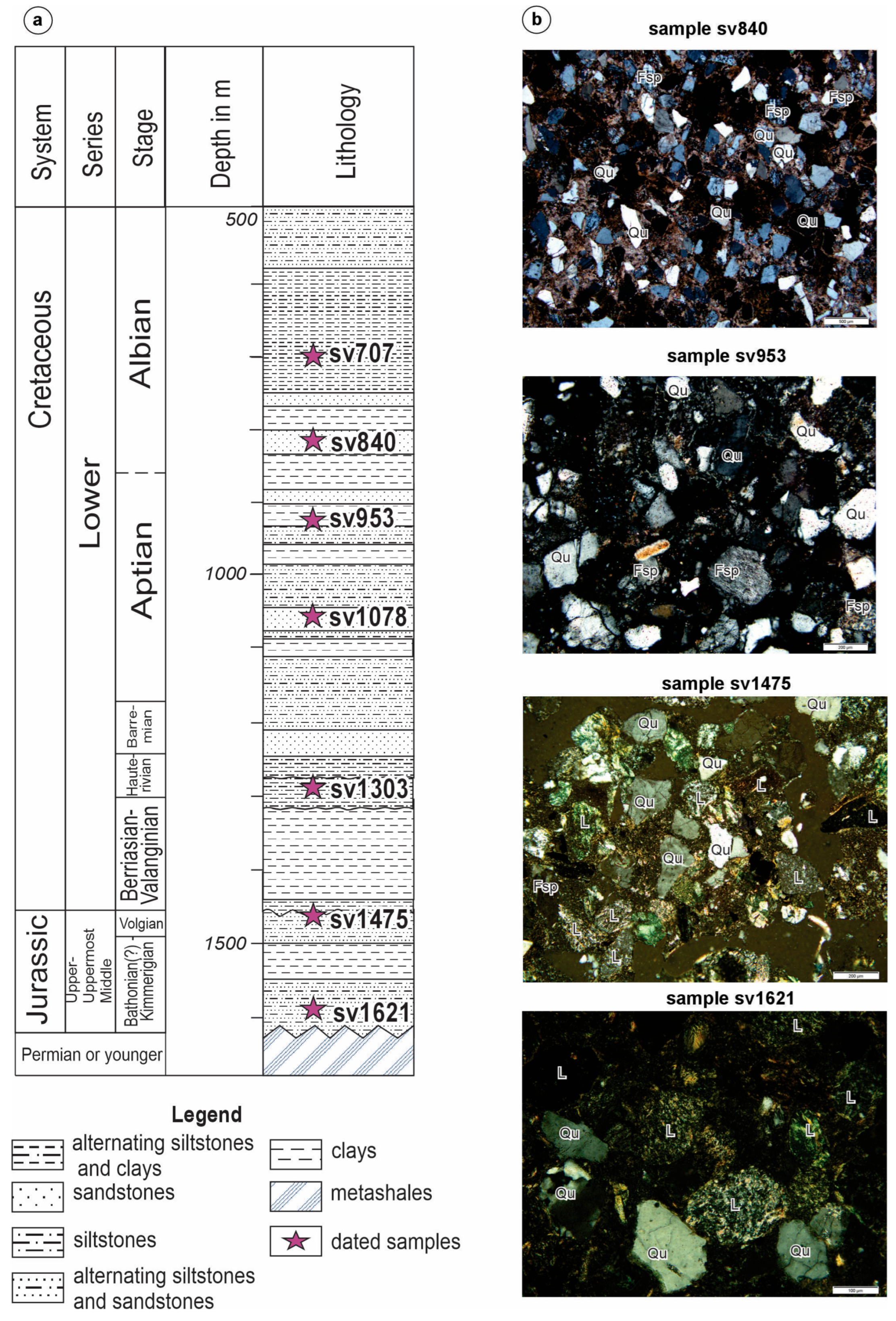
3. Results
3.1. U-Pb Dating of Detrital Zircons
3.2. U-Pb-Dating and Trace Element Analysis of Detrital Rutile
3.3. (U-Th)/He-Dating of Zircons (ZHe)
4. Discussion
4.1. Provenance Interpretation
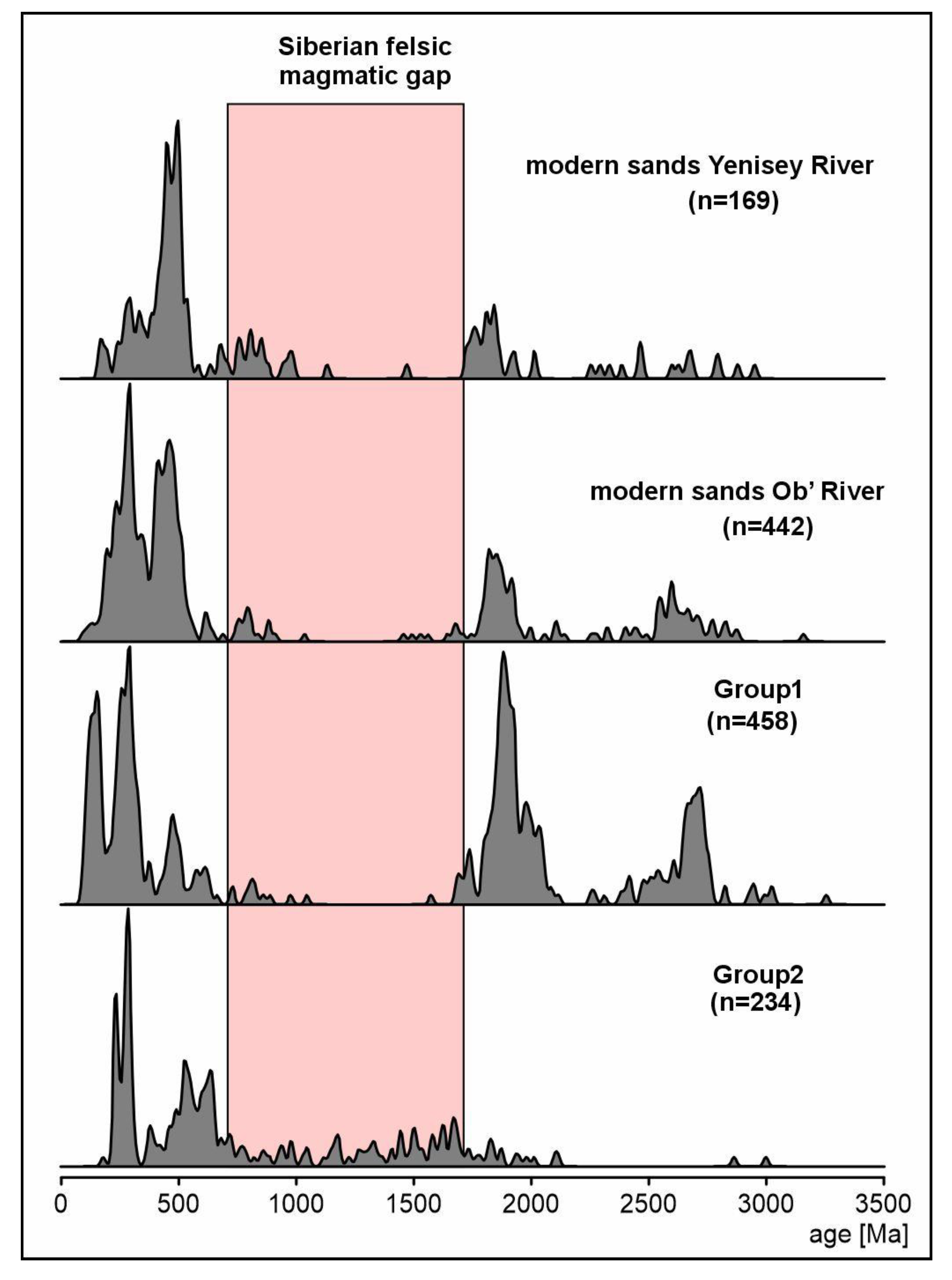
4.2. Implication for Mesozoic Paleogeography of the Arctic
5. Conclusions
Supplementary Materials
Author Contributions
Funding
Conflicts of Interest
References
- Stein, R. The Late Mesozoic-Cenozoic Arctic Ocean Climate and Sea Ice History: A Challenge for Past and Future Scientific Ocean Drilling. Paleoceanogr. Paleoclimatol. 2019, 34, 1851–1894. [Google Scholar] [CrossRef]
- Farley, K.A. (U-Th)/He Dating: Techniques, Calibrations, and Applications. Rev. Mineral. Geochem. 2002, 47, 819–844. [Google Scholar] [CrossRef]
- Reiners, P.W. Zircon (U-Th)/He Thermochronometry. Rev. Mineral. Geochem. 2005, 58, 151–179. [Google Scholar] [CrossRef]
- Zack, T.; Moraes, R.; Kronz, A. Temperature dependence of Zr in rutile: Empirical calibration of a rutile thermometer. Contrib. Mineral. Petrol. 2004, 148, 471–488. [Google Scholar] [CrossRef]
- Zack, T.; von Eynatten, H.; Kronz, A. Rutile geochemistry and its potential use in quantitative provenance studies. Sediment. Geol. 2004, 171, 37–58. [Google Scholar] [CrossRef]
- Zack, T.; Kronz, A.; Foley, S.F.; Rivers, T. Trace element abundances in rutiles from eclogites and associated garnet mica schists. Chem. Geol. 2002, 184, 97–122. [Google Scholar] [CrossRef]
- Zack, T.; Stockli, D.F.; Luvizotto, G.L.; Barth, M.G.; Belousova, E.; Wolfe, M.R.; Hinton, R.W. In situ U–Pb rutile dating by LA-ICP-MS: 208Pb correction and prospects for geological applications. Contrib. Mineral. Petrol. 2011, 162, 515–530. [Google Scholar] [CrossRef]
- Triebold, S.; von Eynatten, H.; Zack, T. A recipe for the use of rutile in sedimentary provenance analysis. Sediment. Geol. 2012, 282, 268–275. [Google Scholar] [CrossRef]
- Cawood, P.A.; Hawkesworth, C.J.; Dhuime, B. Detrital zircon record and tectonic setting. Geology 2012, 40, 875–878. [Google Scholar] [CrossRef]
- Gehrels, G. Detrital Zircon U-Pb Geochronology: Current Methods and New Opportunities. In Tectonics of Sedimentary Basins; Busby, C., Azor, A., Eds.; John Wiley & Sons, Ltd.: Chichester, UK, 2012; pp. 45–62. [Google Scholar]
- Wolfe, M.R.; Stockli, D.F. Zircon (U–Th)/He thermochronometry in the KTB drill hole, Germany, and its implications for bulk He diffusion kinetics in zircon. Earth Planet. Sci. Lett. 2010, 295, 69–82. [Google Scholar] [CrossRef]
- Gramberg, I.S.; Shkola, I.V.; Bro, E.G.; Shekhodanov, V.A.; Armishev, A.M. Parametric Wells on the Islands of the Barents and Kara Seas. Sov. Geol. 1985, 1, 95–98. (In Russian) [Google Scholar]
- Drachev, S.S.; Malyshev, N.A.; Nikishin, A.M. Tectonic history and petroleum geology of the Russian Arctic Shelves: An overview. Geol. Soc. Lond. Pet. Geol. Conf. Ser. 2010, 7, 591–619. [Google Scholar] [CrossRef]
- Andersen, T.; Kristoffersen, M.; Elburg, M.A. Visualizing, interpreting and comparing detrital zircon age and Hf isotope data in basin analysis—A graphical approach. Basin Res. 2018, 30, 132–147. [Google Scholar] [CrossRef]
- Sláma, J.; Košler, J.; Condon, D.J.; Crowley, J.L.; Gerdes, A.; Hanchar, J.M.; Horstwood, M.S.A.; Morris, G.A.; Nasdala, L.; Norberg, N.; et al. Plešovice Zircon—A New Natural Reference Material for U–Pb and Hf Isotopic Microanalysis. Chem. Geol. 2008, 249, 1–35. [Google Scholar] [CrossRef]
- Paton, C.; Hellstrom, J.; Paul, B.; Woodhead, J.; Hergt, J. Iolite: Freeware for the Visualisation and Processing of Mass Spectrometric Data. J. Anal. At. Spectrom. 2011, 26, 2508. [Google Scholar] [CrossRef]
- Petrus, J.A.; Kamber, B.S. VizualAge: A Novel Approach to Laser Ablation ICP-MS U-Pb Geochronology Data Reduction. Geostand. Geoanalytic Res. 2012, 36, 247–270. [Google Scholar] [CrossRef]
- Stacey, J.S.; Kramers, J.D. Approximation of Terrestrial Lead Isotope Evolution by a Two-Stage Model. Earth Planet. Sci. Lett. 1975, 26, 207–221. [Google Scholar] [CrossRef]
- Ludwig, T. Isoplot 3.00: A Geochronological Toolkit for Microsoft Excel; Berkeley Geochronology Center 70: Berkeley, CA, USA, 2003. [Google Scholar]
- Tomkins, H.S.; Powell, R.; Ellis, D.J. The Pressure Dependence of the Zirconium-in-rutile Thermometer. J. Metamorph. Geol. 2007, 25, 703–713. [Google Scholar] [CrossRef]
- Luvizotto, G.L.; Zack, T.; Meyer, H.P.; Ludwig, T.; Triebold, S.; Kronz, A.; Münker, C.; Stockli, D.F.; Prowatke, S.; Klemme, S.; et al. Rutile Crystals as Potential Trace Element and Isotope Mineral Standards for Microanalysis. Chem. Geol. 2009, 261, 346–369. [Google Scholar] [CrossRef]
- Jakobsson, M.; Mayer, L.A.; Bringensparr, C.; Castro, C.F.; Mohammad, R.; Johnson, P.; Ketter, T.; Accettella, D.; Amblas, D.; An, L.; et al. The International Bathymetric Chart of the Arctic Ocean Version 4.0. Sci Data 2020, 7, 176. [Google Scholar] [CrossRef]
- Morozov, A.F.; Petrov, O.V. State Geological Map of the Russian Federation. Scale 1:2,500,000; VSEGEI Publishing House: St. Petersburg, Russia, 2004. (In Russian) [Google Scholar]
- Makariev, A.A. Geological Map of Russian Federation, Scale 1:1,000,000; T-45–48 (Cape Chelyuskin), Explanatory Notes; VSEGEI: St. Petersburg, Russia, 2013. (In Russian) [Google Scholar]
- Ershova, V.B.; Prokopiev, A.V.; Khudoley, A.K.; Andersen, T.; Kullerud, K.; Kolchanov, D.A. U–Pb Age and Hf Isotope Geochemistry of Detrital Zircons from Cambrian Sandstones of the Severnaya Zemlya Archipelago and Northern Taimyr (Russian High Arctic). Minerals 2019, 10, 36. [Google Scholar] [CrossRef]
- Ershova, V.B.; Prokopiev, A.V.; Khudoley, A.K.; Proskurnin, V.F.; Andersen, T.; Kullerud, K.; Stepunina, M.A.; Kolchanov, D.A. New U–Pb isotopic data for detrital zircons from metasedimentary sequences of northwestern Taimyr. Dokl. Earth Sci. 2017, 474, 613–616. [Google Scholar] [CrossRef]
- Ershova, V.B.; Prokopiev, A.V.; Khudoley, A.K.; Shneider, G.V.; Andersen, T.; Kullerud, K.; Makar’ev, A.A.; Maslov, A.V.; Kolchanov, D.A. Results of U–Pb (LA–ICPMS) dating of detrital zircons from metaterrigenous rocks of the basement of the North Kara basin. Dokl. Earth Sci. 2015, 464, 997–1000. [Google Scholar] [CrossRef]
- Pease, V.; Scott, R.A. Crustal affinities in the Arctic Uralides, northern Russia: Significance of detrital zircon ages from Neoproterozoic and Palaeozoic sediments in Novaya Zemlya and Taimyr. J. Geol. Soc. 2009, 166, 517–527. [Google Scholar] [CrossRef]
- Gladkochub, D.P.; Donskaya, T.V.; Wingate, M.T.D.; Mazukabzov, A.M.; Pisarevsky, S.A.; Sklyarov, E.V.; Stanevich, A.M. A one-billion-year gap in the Precambrian history of the southern Siberian Craton and the problem of the Transproterozoic supercontinent. Am. J. Sci. 2010, 310, 812–825. [Google Scholar] [CrossRef]
- Kurapov, M.; Ershova, V.; Khudoley, A.; Luchitskaya, M.; Makariev, A.; Makarieva, E.; Vishnevskaya, I. Late Palaeozoic magmatism of Northern Taimyr: New insights into the tectonic evolution of the Russian High Arctic. Int. Geol. Rev. 2021, 63, 1990–2012. [Google Scholar] [CrossRef]
- Kurapov, M.; Ershova, V.; Khudoley, A.; Luchitskaya, M.; Stockli, D.; Makariev, A.; Makarieva, E.; Vishnevskaya, I. Latest Permian–Triassic magmatism of the Taimyr Peninsula: New evidence for a connection to the Siberian Traps large igneous province. Geosphere 2021, 17, 2062–2077. [Google Scholar] [CrossRef]
- Kurapov, M.Y.; Ershova, V.B.; Makariev, A.A.; Makarieva, E.V.; Khudoley, A.K.; Luchitskaya, M.V.; Prokopiev, A.V. Carboniferous Granitoid Magmatism of Northern Taimyr: Results of Isotopic-Geochemical Study and Geodynamic Interpretation. Geotectonics 2018, 52, 225–239. [Google Scholar] [CrossRef]
- Kurapov, M.Y.; Konopelko, D.L.; Biske, Y.S.; Proskurnin, V.F.; Petrov, S.V.; Proskurnina, M.A.; Berzon, Y.Y.; Ershova, V.B.; Berzin, S.V.; Stepanov, S.Y. Geodynamic Settings of Late Paleozoic–Early Mesozoic Granitoid Magmatism at the Arctic Continental Margins: Insights from New Geochronological and Geochemical Data from the Taimyr Peninsula. Minerals 2024, 14, 423. [Google Scholar] [CrossRef]
- Pogrebitsky, Y.E. Geological Map S-47-49 of Russian Federation (Lake Taimyr); VSEGEI: St. Petersburg, Russia, 1998. (In Russian) [Google Scholar]
- Khudoley, A.K.; Verzhbitsky, V.E.; Zastrozhnov, D.A.; O’Sullivan, P.; Ershova, V.B.; Proskurnin, V.F.; Tuchkova, M.I.; Rogov, M.A.; Kyser, T.K.; Malyshev, S.V.; et al. Late Paleozoic—Mesozoic tectonic evolution of the Eastern Taimyr-Severnaya Zemlya Fold and Thrust Belt and adjoining Yenisey-Khatanga Depression. J. Geodyn. 2018, 119, 221–241. [Google Scholar] [CrossRef]
- Vernikovsky, V.; Vernikovskaya, A.; Proskurnin, V.; Matushkin, N.; Proskurnina, M.; Kadilnikov, P.; Larionov, A.; Travin, A. Late Paleozoic–Early Mesozoic Granite Magmatism on the Arctic Margin of the Siberian Craton during the Kara-Siberia Oblique Collision and Plume Events. Minerals 2020, 10, 571. [Google Scholar] [CrossRef]
- Vernikovsky, V.A. Geodynamic Evolution of Taimyr Fold Area; SB RAS: Novosibirsk, Russia, 1996. (In Russian) [Google Scholar]
- Vernikovsky, V.A.; Pease, V.L.; Vernikovskaya, A.E.; Romanov, A.P.; Gee, D.G.; Travin, A.V. First report of early Triassic A-type granite and syenite intrusions from Taimyr: Product of the northern Eurasian superplume? Lithos 2003, 66, 23–36. [Google Scholar] [CrossRef]
- Vernikovsky, V.A.; Sal’nikova, E.B.; Kotov, A.B.; Ponomarchuk, V.A.; Kovach, V.P.; Travin, A.V.; Yakovleva, S.Z.; Berezhnaya, N.G. Age of postcollision granitoids, northern taimyr: U–Pb, Sm–Nd, Rb–Sr and Ar–Ar data. Dokl. Earth Sci. 1998, 363, 375–378. (In Russian) [Google Scholar]
- Zhang, X.; Pease, V.; Carter, A.; Kostuychenko, S.; Suleymanov, A.; Scott, R. Timing of exhumation and deformation across the Taimyr fold–thrust belt: Insights from apatite fission track dating and balanced cross-sections. Geol. Soc. Lond. Spec. Publ. 2018, 460, 315–333. [Google Scholar] [CrossRef]
- Donskaya, T.V. Assembly of the Siberian Craton: Constraints from Paleoproterozoic granitoids. Precambrian Res. 2020, 348, 105869. [Google Scholar] [CrossRef]
- Priyatkina, N.; Ernst, R.E.; Khudoley, A.K. A preliminary reassessment of the Siberian cratonic basement with new U-Pb-Hf detrital zircon data. Precambrian Res. 2020, 340, 105645. [Google Scholar] [CrossRef]
- Safonova, I.; Maruyama, S.; Hirata, T.; Kon, Y.; Rino, S. LA ICP MS U–Pb ages of detrital zircons from Russia largest rivers: Implications for major granitoid events in Eurasia and global episodes of supercontinent formation. J. Geodyn. 2010, 50, 134–153. [Google Scholar] [CrossRef]
- Tsygankov, A.A.; Burmakina, G.N.; Khubanov, V.B.; Buyantuev, M.D. Geodynamics of Late Paleozoic batholith-forming processes in western Transbaikalia. Petrology 2017, 25, 396–418. [Google Scholar] [CrossRef]
- Yarmolyuk, V.V.; Kuzmin, M.I.; Ernst, R.E. Intraplate geodynamics and magmatism in the evolution of the Central Asian Orogenic Belt. J. Asian Earth Sci. 2014, 93, 158–179. [Google Scholar] [CrossRef]
- Yarmolyuk, V.V.; Nikiforov, A.V.; Kozlovsky, A.M.; Kudryashova, E.A. Late Mesozoic East Asian magmatic province: Structure, magmatic signature, formation conditions. Geotectonics 2019, 53, 500–516. [Google Scholar] [CrossRef]
- Mazukabzov, A.M.; Sklyarov, E.V.; Donskaya, T.V.; Gladkochub, D.P.; Fedorovsky, V.S. Metamorphic core complexes of the Transbaikalia: Review. Geodyn. Tectonophys. 2011, 2, 95–125. [Google Scholar] [CrossRef]
- Donskaya, T.V.; Gladkochub, D.P.; Mazukabzov, A.M.; Wang, T. Late Mesozoic granitoids of the western Transbaikalia (Russia) and their relation to formation of metamorphic core complexes. Geodyn. Tectonophys. 2017, 8, 451–453. [Google Scholar] [CrossRef]
- Donskaya, T.V.; Gladkochub, D.P.; Mazukabzov, A.M.; Wang, T.; Guo, L.; Rodionov, N.V.; Demonterova, E.I. Mesozoic granitoids in the structure of the Bezymyannyi metamorphic-core complex (western Transbaikalia). Russ. Geol. Geophys. 2016, 57, 1591–1605. [Google Scholar] [CrossRef]
- Ripp, G.S.; Izbrodin, I.A.; Doroshkevich, A.G.; Lastochkin, E.I.; Rampilov, M.O.; Sergeev, S.A.; Travin, A.V.; Posokhov, V.F. Chronology of the formation of the gabbro-syenite-granite series of the Oshurkovo pluton, western Transbaikalia. Petrology 2013, 21, 375–392. [Google Scholar] [CrossRef]
- Jolivet, M.; De Boisgrollier, T.; Petit, C.; Fournier, M.; Sankov, V.A.; Ringenbach, J.-C.; Byzov, L.; Miroshnichenko, A.I.; Kovalenko, S.N.; Anisimova, S.V. How old is the Baikal Rift Zone? Insight from apatite fission track thermochronology. Tectonics 2009, 28, TC3008. [Google Scholar] [CrossRef]
- Van Der Beek, P.A.; Delvaux, D.; Andriessen, P.A.M.; Levi, K.G. Early Cretaceous denudation related to convergent tectonics in the Baikal region, SE Siberia. J. Geol. Soc. 1996, 153, 515–523. [Google Scholar] [CrossRef]
- Bagdasaryan, T.E.; Thomson, S.N.; Latyshev, A.V.; Veselovskiy, R.V.; Zaitsev, V.A.; Marfin, A.E.; Zakharov, V.S.; Yudin, D.S. Thermal history of the Siberian Traps Large Igneous Province revealed by new thermochronology data from intrusions. Tectonophysics 2022, 836, 229385. [Google Scholar] [CrossRef]
- Malyshev, S.V.; Khudoley, A.K.; Prokopiev, A.V.; Ershova, V.B.; Kazakova, G.G.; Terentyeva, L.B. Source rocks of Carboniferous–Lower Cretaceous terrigenous sediments of the northeastern Siberian Platform: Results of Sm–Nd isotope–geochemical studies. Russ. Geol. Geophys. 2016, 57, 421–433. [Google Scholar] [CrossRef]
- Vereshchagin, O.S.; Khudoley, A.K.; Ershova, V.B.; Prokopiev, A.V.; Schneider, G.V. Provenance of Jurassic-Cretaceous siliciclastic rocks from the northern Siberian Craton: An integrated heavy mineral study. J. Geosci. 2018, 63, 199–213. [Google Scholar] [CrossRef]
- Holmes, R.M.; McClelland, J.W.; Peterson, B.J.; Shiklomanov, I.A.; Shiklomanov, A.I.; Zhulidov, A.V.; Gordeev, V.V.; Bobrovitskaya, N.N. A circumpolar perspective on fluvial sediment flux to the Arctic ocean: FLUVIAL SEDIMENT FLUX TO THE ARCTIC OCEAN. Glob. Biogeochem. Cycles 2002, 16, 45-1–45-14. [Google Scholar] [CrossRef]
- Holmes, R.M.; Shiklomanov, A.I.; Suslova, A.; Tretiakov, M.; McClelland, J.W.; Spencer, R.G.M.; Tank, S.E. River Discharge. 2018. Available online: https://www.arctic.noaa.gov/Report-Card/Report-Card-2018/ArtMID/7878/ArticleID/786/River-Discharge (accessed on 15 May 2021).
- Shephard, G.E.; Müller, R.D.; Seton, M. The tectonic evolution of the Arctic since Pangea breakup: Integrating constraints from surface geology and geophysics with mantle structure. Earth-Sci. Rev. 2013, 124, 148–183. [Google Scholar] [CrossRef]
- Herrle, J.O.; Schröder-Adams, C.J.; Davis, W.; Pugh, A.T.; Galloway, J.M.; Fath, J. Mid-Cretaceous High Arctic stratigraphy, climate, and Oceanic Anoxic Events. Geology 2015, 43, 403–406. [Google Scholar] [CrossRef]
- Midtkandal, I.; Svensen, H.H.; Planke, S.; Corfu, F.; Polteau, S.; Torsvik, T.H.; Faleide, J.I.; Grundvåg, S.-A.; Selnes, H.; Kürschner, W.; et al. The Aptian (Early Cretaceous) oceanic anoxic event (OAE1a) in Svalbard, Barents Sea, and the absolute age of the Barremian-Aptian boundary. Palaeogeogr. Palaeoclimatol. Palaeoecol. 2016, 463, 126–135. [Google Scholar] [CrossRef]
- Mutterlose, J.; Pauly, S.; Steuber, T. Temperature controlled deposition of early Cretaceous (Barremian–early Aptian) black shales in an epicontinental sea. Palaeogeogr. Palaeoclimatol. Palaeoecol. 2009, 273, 330–345. [Google Scholar] [CrossRef]
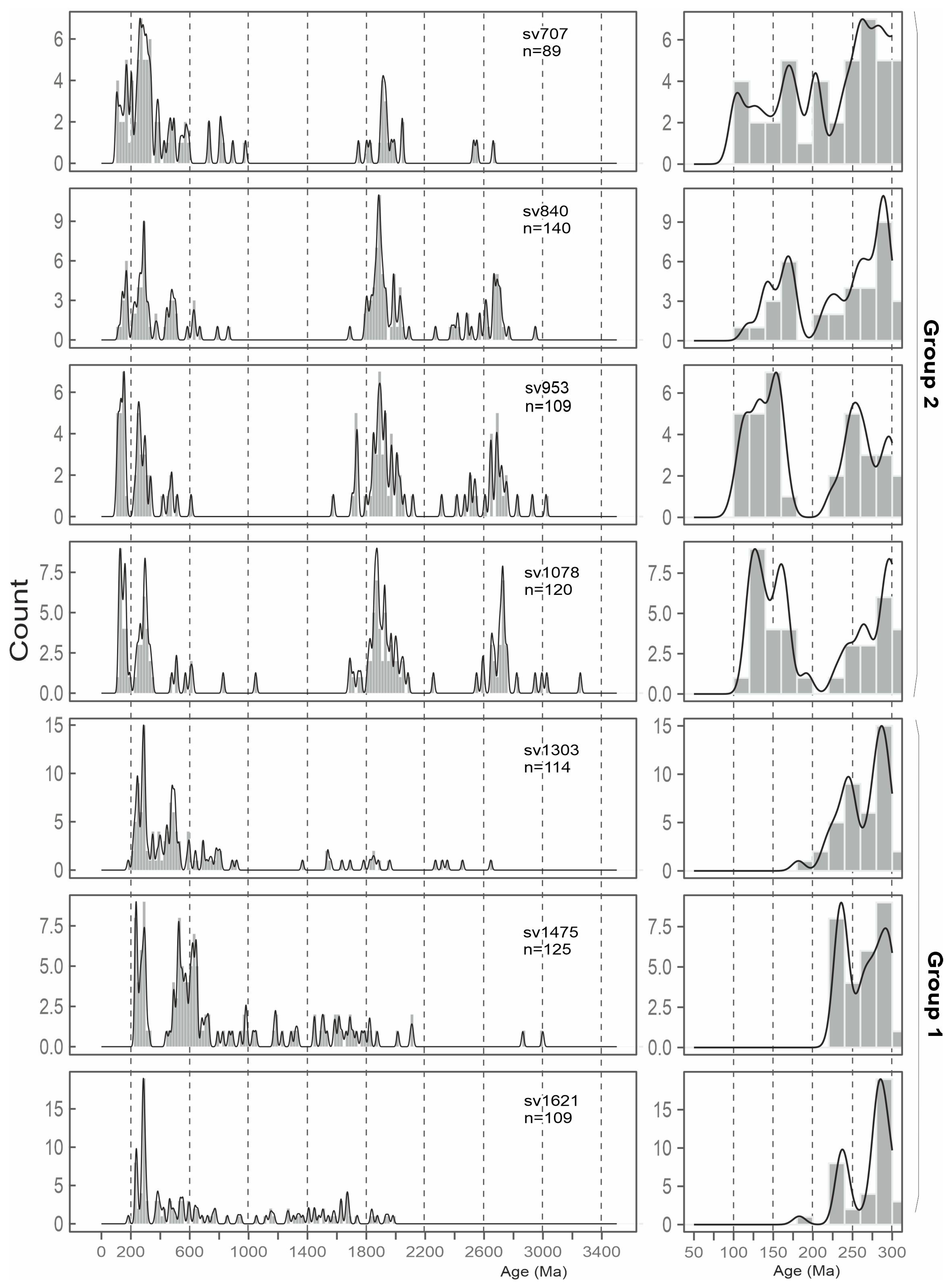

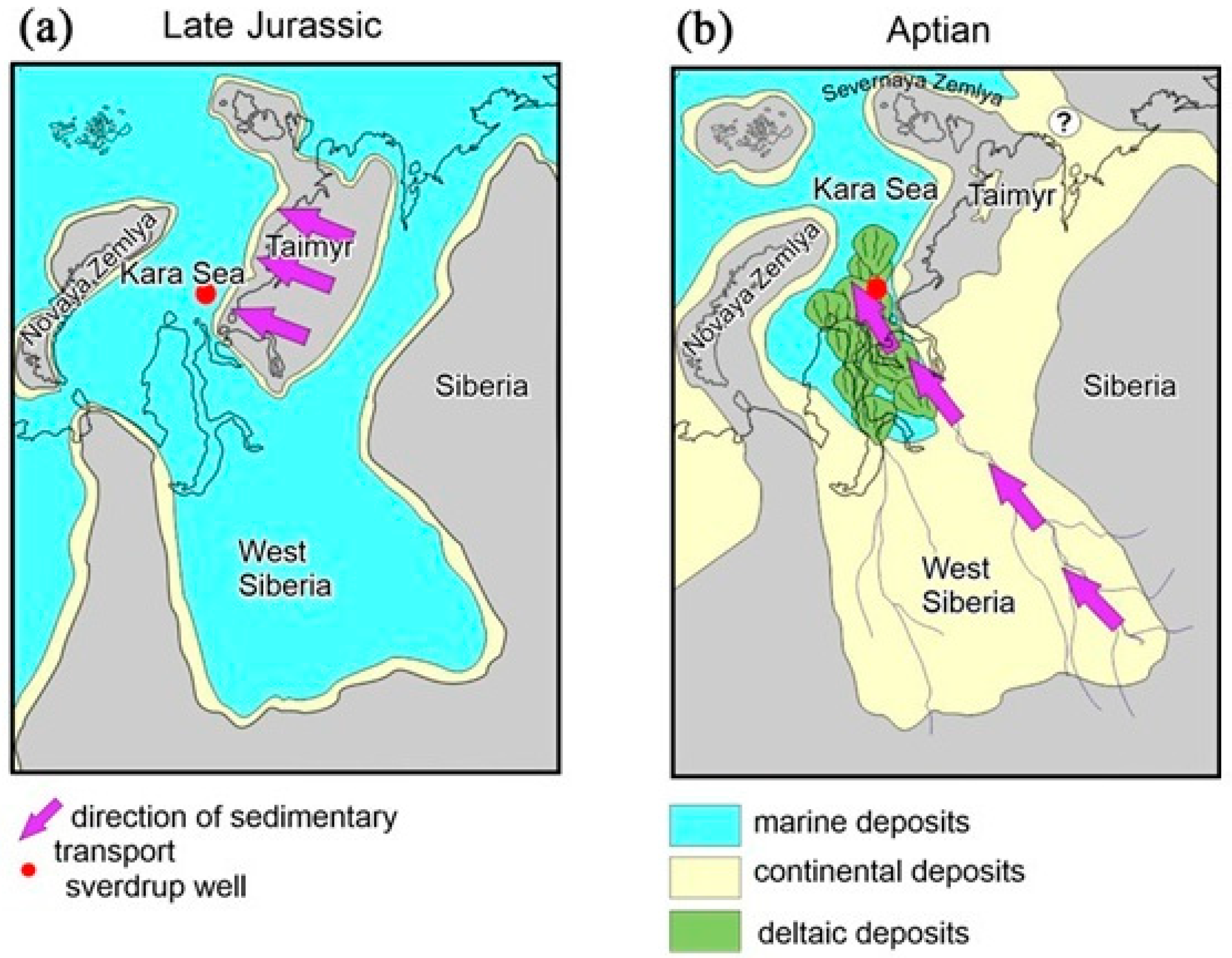
Disclaimer/Publisher’s Note: The statements, opinions and data contained in all publications are solely those of the individual author(s) and contributor(s) and not of MDPI and/or the editor(s). MDPI and/or the editor(s) disclaim responsibility for any injury to people or property resulting from any ideas, methods, instructions or products referred to in the content. |
© 2025 by the authors. Licensee MDPI, Basel, Switzerland. This article is an open access article distributed under the terms and conditions of the Creative Commons Attribution (CC BY) license (https://creativecommons.org/licenses/by/4.0/).
Share and Cite
Ershova, V.; Stockli, D.; Gaina, C.; Khudoley, A.; Shimanskiy, S. When Big Rivers Started to Drain to the Arctic Basin: A View from the Kara Sea. Geosciences 2025, 15, 342. https://doi.org/10.3390/geosciences15090342
Ershova V, Stockli D, Gaina C, Khudoley A, Shimanskiy S. When Big Rivers Started to Drain to the Arctic Basin: A View from the Kara Sea. Geosciences. 2025; 15(9):342. https://doi.org/10.3390/geosciences15090342
Chicago/Turabian StyleErshova, Victoria, Daniel Stockli, Carmen Gaina, Andrey Khudoley, and Sergey Shimanskiy. 2025. "When Big Rivers Started to Drain to the Arctic Basin: A View from the Kara Sea" Geosciences 15, no. 9: 342. https://doi.org/10.3390/geosciences15090342
APA StyleErshova, V., Stockli, D., Gaina, C., Khudoley, A., & Shimanskiy, S. (2025). When Big Rivers Started to Drain to the Arctic Basin: A View from the Kara Sea. Geosciences, 15(9), 342. https://doi.org/10.3390/geosciences15090342





